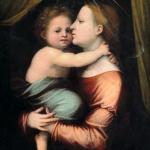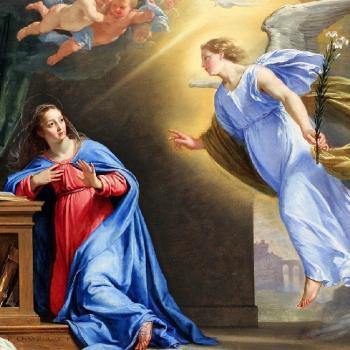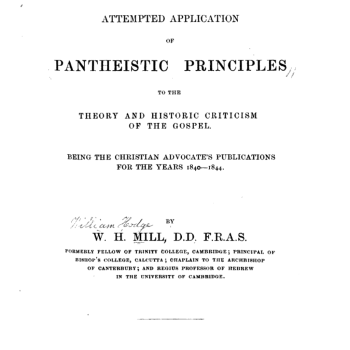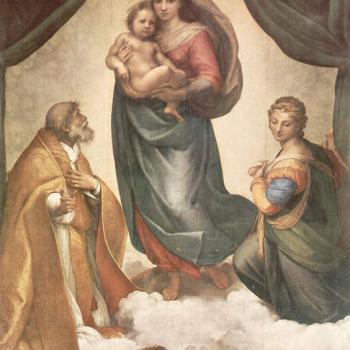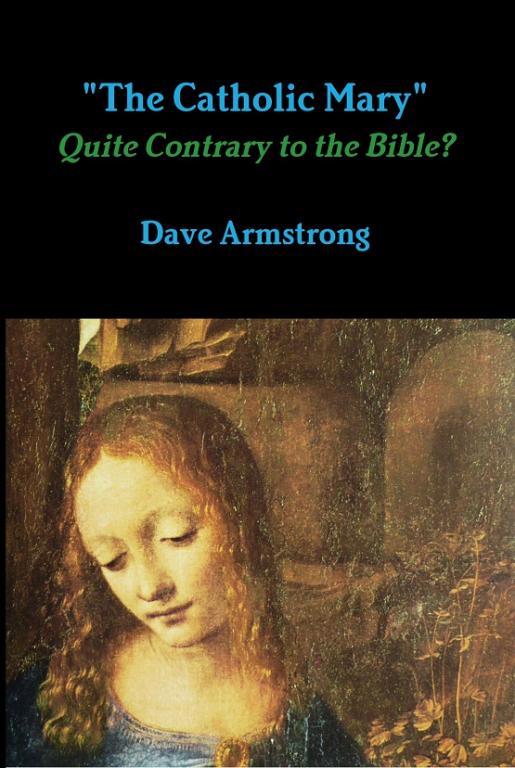
[book and purchase information]
Mother of God
The ecumenical council of Ephesus in 431 declared Mary the Mother of God (Greek, Theotokos) in order to safeguard the divinity of Christ, which was being attacked by the Nestorians, a heretical group which had recently arisen. Since Christ was God in the flesh (Col 2:9; Jn 1:1,14), Mary is the Mother of God the Son. Both Luther and Calvin (along with all the major Protestant founders) agreed. But she is a creature, like us, and is not worshiped in Catholicism as a sort of goddess. She is venerated due to the unfathomable honor of having been chosen to bear and raise the incarnate God.
Mary’s Immaculate Conception
Catholics believe that God saved Mary in a special way, preventing her from sin, because of her extraordinary role and proximity to God the Son and Holy Spirit (Lk 1:35). An angel called Mary highly favored or full of grace in Luke 1:28. The Greek word, kecharitomene, means “completely, perfectly, enduringly endowed with grace.” On this and other grounds, Catholics hold that she was free of sin from conception and throughout her life. Even Luther agreed! The medieval theologians constructed an interesting word-picture to illustrate how Mary was just as saved as we are (Lk 1:47), yet in a different sense. Imagine a pit in a forest path, representing the quagmire of sin.
All of us are in that pit, wallowing in the mud. But God will pull us out of it and redeem us, provided we are willing. With Mary, God did something different. He never allowed her (unlike us) to fall into this pit. But in both cases, whether through prevention or rescue, it is equally true that it is God alone who saves. Mary is everything she is due to the unmerited, free grace of God, not because of some intrinsic superiority, regarded as originating separately from God.
Ark, Temple, Tabernacle, and Mary
The closer one is to God, the holier one must be (e.g., Ex 3:5; Deut 23:14). God’s presence imparts holiness (1 Cor 3:13-17; 1 Jn 3:3-9). The Jewish high priest entered the “Holy of holies” in the tabernacle or temple only once a year, under pain of death (Lev 16:2-4, 13). The ark of the covenant was so holy only a few could touch it (Num 4:15; 2 Sam 6:2-7). Scripture compares Mary to the ark (Lk 1:35 and Ex 40:34-8 / Lk 1:44 and 2 Sam 6:14-16 / Lk 1:43 and 2 Sam 6:9). If mere inanimate objects can be so “holy” due to proximity with God, how much more so Mary, who bore God? Protestants often have difficulty with this conception because of their faulty view of mere external, “legal” justification, which doesn’t necessarily lead to actual, objective holiness.
Mary’s Bodily Assumption
The Assumption is not an arbitrary presumption. It follows from Mary’s sinlessness. Since bodily decay results from sin (Ps 16:10; Gen 3:19), the absence of sin allows for instant bodily resurrection at death (i.e., the Assumption). Mary shared (in a secondary, derivative fashion) in her Son’s victory over sin, death, and the devil (Heb 2:14-15), as foretold in Genesis 3:15. She was the “firstfruits” of Christ’s work on our behalf, which will eventually put an end to death and result in all saints having glorious, incorruptible bodies.
It was proper and appropriate for Mary — since she was the mother of God the Son — to “prefigure” the redeemed world to come by means of both her Immaculate Conception and Assumption. Scripture provides examples of occurrences similar to the Assumption: Enoch (Gen 5:24; cf. Heb 11:5), Elijah (2 Ki 2:11), St. Paul (2 Cor 12:2, 4), the so-called “Rapture” (1 Thess 4:15-17), risen saints after Jesus’ crucifixion (Mt 27:52-3). It is illogical and unacceptably dogmatic to assert that an event couldn’t have happened because it was not recounted in Scripture. This would be as foolish as saying that Jesus couldn’t have done any miracles other than those we find in the Bible (see Jn 20:30; 21:25). If the Assumption is not that radically different from many other occurrences in Scripture, flows from the interrelated theological notions explicitly found there, and is supported by the testimony of early Christian tradition, it is neither “idolatrous” nor “unbiblical” to believe in it.
The Blessed Virgin Mary
All the Protestant Founders (Luther, Calvin, Zwingli, etc.) firmly believed in Mary’s perpetual virginity, but some Protestants since have claimed that Jesus had siblings. The Greek word for “brother,” adelphos, can and does mean many things in Scripture: nationality (Acts 3:17, 22), neighbor (Mt 7:3; 23:8), even all mankind (Mt 25:40). Several other biblical arguments exist also. No one sought to deny this tradition until the late 4th century, when one Helvidius unsuccessfully tangled with St. Jerome.
Mary Our Spiritual Mother and Intercessor
The idea of Mary as the Mother of believers is derived most directly from John 19:26-27, where Jesus tells St. John from the cross to “behold thy mother.” Mary is also Mother and symbol of the Church in Revelation 12:1, 5, 17. Catholics believe that they greatly benefit from Mary’s intercession because of her sinlessness (Jas 5:16). Since Mary is incomparably more alive and holy than we are, to ask for her prayers (Rev 5:8; 6:9-10) is good biblically based “spiritual sense.”
***
(originally from 1995)
***



